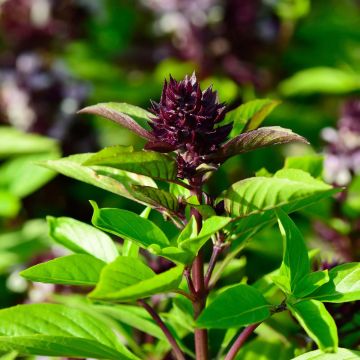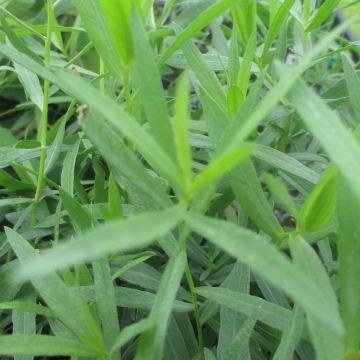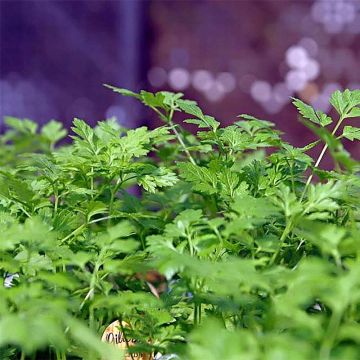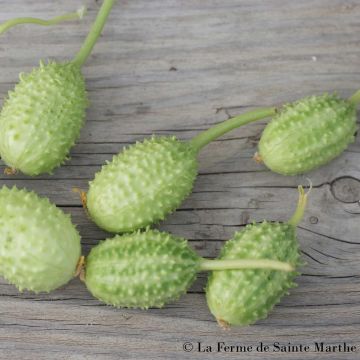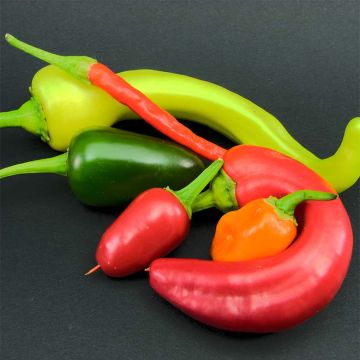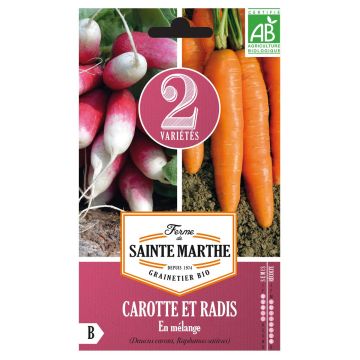

Aneth Thalia Bio - Graines
Anethum graveolens Thalia
Anethum graveolens Thalia
Dill, Anis
This item cannot be shipped to the selected country
Dispatch by letter from €3.90
More information
Schedule delivery date,
and select date in basket
This plant carries a 6 months recovery warranty
More information
We guarantee the quality of our plants for a full growing cycle, and will replace at our expense any plant that fails to recover under normal climatic and planting conditions.
Seed-only orders are dispatched by sealed envelope. The delivery charge for seed-only orders is €3.90.
Description
The Organic Thalia Dill is a homogeneous and robust variety, producing high yields from spring to the end of summer. Its finely cut, aromatic foliage, dark green in colour, has a flavour of anise, mint, and fennel. It forms a dense clump 40 cm (16in) tall. Sow from March to May for a harvest from May to October. These seeds come from organic farming.
Dill (Anethum graveolens), also known as Anis, is an annual aromatic plant native to the Mediterranean basin. It belongs to the Apiaceae family (formerly Umbelliferae) and produces, in summer, charming pendulous flowers in a beautiful acidic yellow colour, perched on long stems. Its foliage consists of very fine green leaves, giving it a slightly ethereal appearance. It is a fast-growing plant whose height varies depending on the variety.
Dill is cultivated as a culinary herb, for its leaves, but also for its seeds. In cooking, it is used to flavour fish, marinades, cold sauces, cottage cheese... Its seeds enhance court-bouillon and relieve digestive problems. Dill can also be consumed as an infusion, and it is said to promote sleep according to some.
It is also a very beautiful annual that insects love and that can confidently be displayed in ornamental gardens or in wildflower bouquets.
In the garden, you can plant it in a sunny spot in rather rich, light, and well-drained soil.
Harvesting: at the beginning of growth, harvest the leaves as you need them, then enjoy its beautiful flowering for a few weeks and, after running to seed, cut the flowers, harvest the seeds, and let them dry on newspaper or fabric.
Storage: it is possible to store dill leaves and seeds, after drying in the shade, in airtight containers.
Gardener's tips: Dill will be a great companion for many of your vegetable plants: it repels carrot fly, aphids, red spiders, and leek moth. The proximity of cabbage makes dill more resistant and productive.
Report an error about the product description
Harvest
Plant habit
Foliage
Botanical data
Anethum
graveolens
Thalia
Apiaceae
Dill, Anis
Cultivar or hybrid
Annual
Other Herb seeds
Planting and care
Sowing: Dill likes a fresh and loose, light, humus-rich soil. It also needs a sunny position to develop well. Dill is afraid of wind exposure. Sowing is done in spring, from the month of March under shelter and from the month of April in open ground until the beginning of summer. Sow in a well-aerated row, in a flat furrow about 10 cm (4in) wide and 2 cm (1in) deep. The rows should be spaced 25 cm (10in) apart. Cover the seeds with the soil spread along the furrow, then water. Germination takes between 10 and 15 days. As soon as the first plants appear, thin them out every 20 cm (8in). The more staggered the sowing, the longer the harvesting period will be.
Maintenance: Dill requires very little maintenance. Simply water when the soil dries out. Ideally, mulch should be placed at its base, as it is the lack of water (water stress) that can cause dill to bolt too early.
Transplanting: Place one plant every 30 cm (12in).
Seedlings
Care
Intended location
This item has not been reviewed yet - be the first to leave a review about it.
Vegetable seeds
Haven't found what you were looking for?
Hardiness is the lowest winter temperature a plant can endure without suffering serious damage or even dying. However, hardiness is affected by location (a sheltered area, such as a patio), protection (winter cover) and soil type (hardiness is improved by well-drained soil).

Photo Sharing Terms & Conditions
In order to encourage gardeners to interact and share their experiences, Promesse de fleurs offers various media enabling content to be uploaded onto its Site - in particular via the ‘Photo sharing’ module.
The User agrees to refrain from:
- Posting any content that is illegal, prejudicial, insulting, racist, inciteful to hatred, revisionist, contrary to public decency, that infringes on privacy or on the privacy rights of third parties, in particular the publicity rights of persons and goods, intellectual property rights, or the right to privacy.
- Submitting content on behalf of a third party;
- Impersonate the identity of a third party and/or publish any personal information about a third party;
In general, the User undertakes to refrain from any unethical behaviour.
All Content (in particular text, comments, files, images, photos, videos, creative works, etc.), which may be subject to property or intellectual property rights, image or other private rights, shall remain the property of the User, subject to the limited rights granted by the terms of the licence granted by Promesse de fleurs as stated below. Users are at liberty to publish or not to publish such Content on the Site, notably via the ‘Photo Sharing’ facility, and accept that this Content shall be made public and freely accessible, notably on the Internet.
Users further acknowledge, undertake to have ,and guarantee that they hold all necessary rights and permissions to publish such material on the Site, in particular with regard to the legislation in force pertaining to any privacy, property, intellectual property, image, or contractual rights, or rights of any other nature. By publishing such Content on the Site, Users acknowledge accepting full liability as publishers of the Content within the meaning of the law, and grant Promesse de fleurs, free of charge, an inclusive, worldwide licence for the said Content for the entire duration of its publication, including all reproduction, representation, up/downloading, displaying, performing, transmission, and storage rights.
Users also grant permission for their name to be linked to the Content and accept that this link may not always be made available.
By engaging in posting material, Users consent to their Content becoming automatically accessible on the Internet, in particular on other sites and/or blogs and/or web pages of the Promesse de fleurs site, including in particular social pages and the Promesse de fleurs catalogue.
Users may secure the removal of entrusted content free of charge by issuing a simple request via our contact form.
The flowering period indicated on our website applies to countries and regions located in USDA zone 8 (France, the United Kingdom, Ireland, the Netherlands, etc.)
It will vary according to where you live:
- In zones 9 to 10 (Italy, Spain, Greece, etc.), flowering will occur about 2 to 4 weeks earlier.
- In zones 6 to 7 (Germany, Poland, Slovenia, and lower mountainous regions), flowering will be delayed by 2 to 3 weeks.
- In zone 5 (Central Europe, Scandinavia), blooming will be delayed by 3 to 5 weeks.
In temperate climates, pruning of spring-flowering shrubs (forsythia, spireas, etc.) should be done just after flowering.
Pruning of summer-flowering shrubs (Indian Lilac, Perovskia, etc.) can be done in winter or spring.
In cold regions as well as with frost-sensitive plants, avoid pruning too early when severe frosts may still occur.
The planting period indicated on our website applies to countries and regions located in USDA zone 8 (France, United Kingdom, Ireland, Netherlands).
It will vary according to where you live:
- In Mediterranean zones (Marseille, Madrid, Milan, etc.), autumn and winter are the best planting periods.
- In continental zones (Strasbourg, Munich, Vienna, etc.), delay planting by 2 to 3 weeks in spring and bring it forward by 2 to 4 weeks in autumn.
- In mountainous regions (the Alps, Pyrenees, Carpathians, etc.), it is best to plant in late spring (May-June) or late summer (August-September).
The harvesting period indicated on our website applies to countries and regions in USDA zone 8 (France, England, Ireland, the Netherlands).
In colder areas (Scandinavia, Poland, Austria...) fruit and vegetable harvests are likely to be delayed by 3-4 weeks.
In warmer areas (Italy, Spain, Greece, etc.), harvesting will probably take place earlier, depending on weather conditions.
The sowing periods indicated on our website apply to countries and regions within USDA Zone 8 (France, UK, Ireland, Netherlands).
In colder areas (Scandinavia, Poland, Austria...), delay any outdoor sowing by 3-4 weeks, or sow under glass.
In warmer climes (Italy, Spain, Greece, etc.), bring outdoor sowing forward by a few weeks.



































